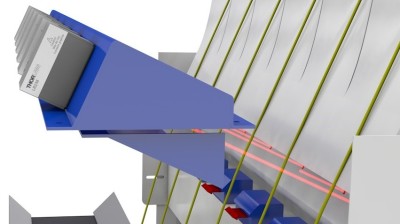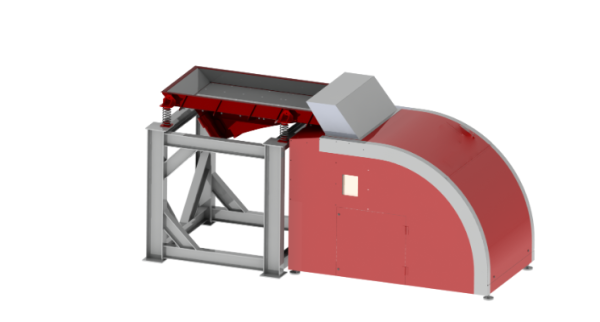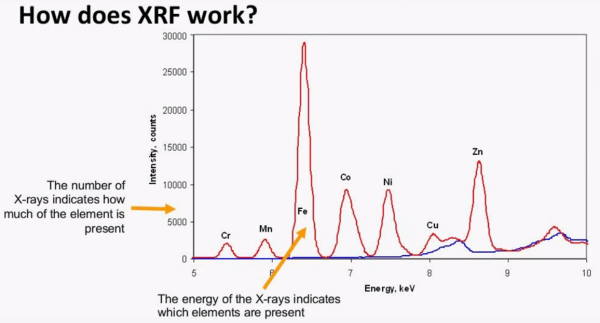
High End X-Ray Technology
X-Ray Modern sensor-based sorting technologies offer much-enhanced sorting functionality, sorting scrap into different grades by elements like Cu, Zn etc. and removing unwanted products.

X-Ray Fluorescence technique (XRF)
XRT Sensor-based, density sorting alone is not good enough for most aluminum recycling applications.
Chemistry is the key!
I. INNOVATION and AUSTIN AI
How LIBS works?

How XRF works?
Schematic illustration of XRF detection
How XRF works?
II. INNOVATION and AUSTIN AI
How XRF work for you?
III. INNOVATION and AUSTIN
How XRF improve your bottom line ?
- Scrap must be of appropriate quality before it can be melted down.
- Why are single elements of interest important to the secondary smelter?
- In summary, the difference in one element’s presence or absence in furnace feedstock can dramatically affect the mill’s performance.
- For example, if the incoming feedstock is a Twitch-like material (a mix of wrought and cast scrap), then the furnace operator must either increase the amount of alloying Si if he is making a cast Al product; or he must dilute down the Si if he is making a wrought product.
- In the former case, the operator adds Si metal to the molten Al to get the Si up to spec. In the latter case, the operator adds pure Al ingot to reduce the Si to spec. In both cases these pot adjustments means there is...
1) significant added energy consumption
keeping the melt at temperature;
2) longer pot time (lower turnover); and,
3) added feed material costs.
- The argument becomes more dramatic when the case for Mg is analyzed. (see also Austin AI LIBS Technology)
- More and more Mg metal is finding its way into feedstock from today’s scrap shredder process. This is a result of increased usage in automobile manufacturing, mainly.
- Referring back to the Twitch product, Mg levels can be at 3%-5%, or more.
- For most secondaries there is a need to reduce this Mg content to lower values.
- This is typically done via the addition of chlorine to the molten metal and the subsequent creation of a floating Mg slag that is drawn off.
adjustment case, there are the incremental arguments
supporting removal/reduction of the Mg metal before
melting.
4) increased capacity per turnover;
5) reduction in chlorine usage;
6) reduction in the waste Mg slag; and
7) creation of an asset as the pre-extracted Mg
metal is a tradable commodity (typically trading
higher than the subject Al metal).
- These are seven powerful drivers providing quick ROI for those adding Mg extraction technology to tprocessing line.
- Finally, one can achieve “closing the loop” in aluminum recycling to the point of ultimate alloy specificity.
- As an example, alloys of the 5xxx and 6xxx series can be sorted in addition with Austin AI LIBS Technology.
- This is done with LIBS (Laser Induced Breakdown Spectroscopy).
- Several key applications are the sorting of Aluminum extruded parts (typically 6XXX series) and automotive recycling applications (where 5XXX series alloys are common).
- Latest XRF and LIBS sorting technologies are the final step to a cradle-to-cradle process, resulting in huge energy savings and highly profitable recycling operations.
-
Nearly all elements, from iron to copper to nickel to tungsten, have unique and known X-ray signatures.
-
When an X- or Gamma-ray is absorbed by an element, the element fluoresces, or emits energy. Inner-shell atomic fluorescence produces the X-ray signature, and can be "captured" and reported.
-
XRF analyzers do both tasks: they provide the incident X-rays that generate the excitation in the atoms and then detect the fluorescence from most of the elements in the sample material
- In the recent past, sorting Aluminum alloys by means of XRT (X-ray-Transmission) technology has been tried.
However, this expensive sensor technology (based on the physical property of material density) is not precise
enough for specific alloy sorting.
- Additionally, extra material preparation stages like sizing for XRT sorting is costly and time consuming.
- Sorting with XRT has demonstrated to be cost inefficient and yielding poor product quality when used beyond the stage of rough sorting light and heavy metal alloys commonly found in shredder scrap.
- The scrap processor to scrap consumer business link is therefore in need of a better bridge by which they may conduct their trade.
- In the Austin AI model, the XRT approach is thus followed by XRF (X-Ray Fluorescence) technique.
- Using the XRF sensor technology, aluminum alloys can be classified cost efficiently, at a high quality, and at an economically viable throughput performance.
- Different than XRT, which results merely in black white imaging as sorting criteria, XRF sensing allows the definition of plain material composition according to the atomic elements table.
- XRF, and its partner technology in Austin AI first-of-its-kindscrap metal processing line, LIBS, are elemental analyzers that use the chemistry of the target material for identifying or sorting criteria.
- For example, the XRF technology has proven usage for the scrap metal processors in sorting their Zorba und Zurik. XRF extracts Zn, Cu, Ni, Fe, etc., from the Zorba; and extract only PCB’s or Cu from Zurik material.

Austin AI XRF Maschine
- Scrap must be of appropriate quality before it can be melted down.
- To obtain this level of quality, all adherent materials must be removed.
- Depending on scrap type, aluminum losses of about 2% to10% may be incurred during separation of aluminum from other materials.
- A certain degree of material loss is inevitable with industrial processes but, because of aluminum’s high intrinsic value, all efforts are directed at minimizing losses.
- For example end-of-life products are often not mechanically separable into single material output fractions. A dilution of foreign materials within each output is the result.
- The treatment of scrap is a joint undertaking by the aluminum recycling industry and specialized scrap processors.
- Almost all aluminum used commercially contains one or more alloying elements to enhance its strength or other properties.
- Aluminum recycling therefore contributes to the sustainable use of copper, iron, magnesium, manganese, silicon, zinc and other elements.
- Implementing new technology in the form of LIBS and XRF sorting is maximizing recycling quantities accordingly and opens up up-to-date eco efficient process optimization

Salient point 1) - 3)

In addition to the salient point 1) - 3) above for the Si...

These are:
Austin AI XRF Machine
AUSTIN AI XRF Sensor Sorters are:
Capable of processing up to 6 tons/hour, or more, depending on material density and piece size range.
Designed to be quickly field upgradable for increased capacity
Multi-Application Program Capable
AUSTIN AI builds to German Specifications but MADE in AMERICA